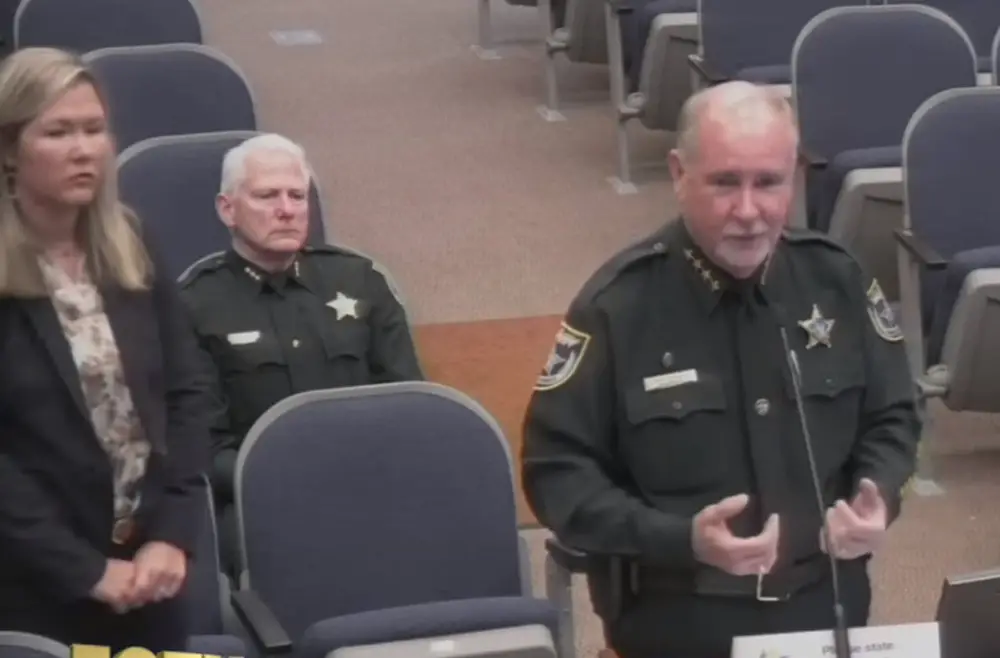
The Flagler County Sheriff’s Office has a current deficit of 37 road deputies, according to an analysis by the University of North Florida produced for the Sheriff’s Office, Palm Coast and the county. The analysis is intended to yield an objective, permanent method of paying for law enforcement based on calls for service.
Don’t expect those deputies to be hired in one swoop, but the sheriff’s plan is to have the county and Palm Coast jointly hire 12 deputies next year, 12 in 2026, and 13 in 2027, by which time they would be “caught up” with needs. Beyond that, they would have to hire about five deputies a year, based on growth.
The analysis was the centerpiece of a joint meeting today of the two governments and the Sheriff’s Office, which is funded by the County Commission, contracting separately with Palm Coast for supplemental policing. Palm Coast does not have its own police department.
Flagler County Sheriff Rick Staly last year requested that the county and city develop a joint staffing plan.
“As a sheriff,” Flagler County Sheriff Rick Staly said, “I’m kind of caught in the middle between the County Commission and the city of Palm Coast with competing interests on who is responsible for the service level for specifically law enforcement in Flagler County. That was the impetus for this meeting, along with the studies that we had previously commissioned on staffing needs of the sheriff’s office and the growth.”
Calls for service is key to the funding method. Calls for service by residents have risen from 43,385 in 2019-20 to 49,631 last year, although total calls for service have remained flat, at just over 119,000. The total includes calls initiated by community policing. It does not include calls generated in Bunnell and Flagler Beach. A little over 82 percent of the calls for service are in Palm Coast, Staly said.
He went further, suggesting that the ratio could be used as a guide in coming years when the county and the city are deciding how to share the burden. “Those are all decision points to be made,” he said, proposing various ways to offset the cost of initial deputy hires with development impact fees. That revenue may be used for capital expenses such as patrol cars and guns and ammunition, but not salaries.
The average call for service by law enforcement is 121 minutes on average. That metric is used to calculate the number of deputies needed to cover shifts. Using those metrics, “the meat and potatoes,” as Palm Coast Acting manager Lauren Johnston described it, one deputy sheriff would be required for every 308 calls for service. That’s the key number.
That calculation would enable the local governments to determine more precisely the need for additional deputies, if any, simply by applying the formula based on each year’s difference in calls for service.
The crime rate is going down steeply even as the population has grown. “We also know that our crime rate is going down because our population is growing older,” Johnston said, as she also cited technological improvements such as the Real Time Crime Center and inmate rehabilitation programs.
Close to a year of meetings to develop the presentation today, involving Johnston and Mark Strobridge, the sheriff’s chief of staff, especially. Staly made a plug for “She could be a high paid consultant right now on manpower staffing studies for law enforcement across the country,” he said. Johnston returned the compliments.
Johnston said that often, law enforcement needs are based on a per-capita approach–the 2.4 deputies per 1,000 residents recommended by public safety associations. “However, there are some limitations to using the per-capita approach for law enforcement,” Johnston said, such as intensity of workload, demographics (older people require less law enforcement), environmental differences, and so on.
There has been significant increases in funding for law enforcement, but calls for service have continued to increase. Last year there were no new additional road deputies. The increases in uniformed deputies were at the county jail. The road deputy deficit has been growing over the last few years: 141 law enforcement officers were needed in 2021, leaving a deficit of 24. In 2023, 161 were needed, creating the deficit of 37 deputies.
“We’re talking strictly about law enforcement,” Staly said. The numbers don’t include other factors such as detention and courts, which have their own impacts. In addition, every 2.4 deputies require one support staffer. He said Palm Coast will also need an additional district office in coming years.
Council member Nick Klufas asked whether technology, which the sheriff has touted for years, could be used as a “force multiple” to slow the need for additional deputies. “I think we’ve reached the saturation factor for that,” Staly said. When people call, they want a deputy. “It makes it more effective, but I think we’re at the point now where where you got to have people answer the calls.”
For the local governments, the county and Palm Coast must now decide to what extent they will rely on the new methodology, how they intend to share the burden, and how they will pay for it all. Johnston provided only two specific options: the property tax, which local officials have been loath to raise for whatever reason, and an additional half-penny sales surtax.
Commissioner Greg Hansen said a sales surtax would be “helpful,” though Palm Coast Mayor David Alfin took exception for the way Hansen said Palm Coast “bombed” the proposal before it had a chance to be vetted. In fact, the city rejected the proposal a few years ago, when the county first suggested it and when Alfin was not on the council. When the county proposed it again last year, it bombed itself before the proposal had a chance to get to Palm Coast, because it was done clumsily and with wrong facts. (“I was part of the minority that did recommend passing along the recommendation for the half cent sales tax,” Council member Nick Klufas said.) That tax would be for both police and fire.
Council member Theresa Pontieri favors an objective metric that can be applied year after year, as long as it is compared to that of other cities to ensure that the assumptions validate the results. But she was amply supportive of the proposed approach.
“I don’t know what the appetite is to come to a unified level of service between the county and the city,” Pontieri said. “But I at the very least hope that our city council is willing to adopt a resolution after we get some of these data points and have a more in-depth conversation based on those, so that we can have a resolution or adopt something that we can continuously fall back on and that future city councils can fall back on and rely on so that when we come up with the budget every year, we’re not caught off guard, and we can budget for all of public safety, including fire and police.”
Some of the questions from the panel were peripheral to the hard issues facing the elected. Who, one of the council members asked, was the sheriff competing for when hiring? Other agencies, he said–with the Orange County Sheriff’s Office having 200 openings, the St. Johns County Sheriff’s Office likely getting 25 new deputies, and millennials having different work priorities than their predecessors: overtime is not their obsession.
Next, the staffers will produce some of the additional data the elected have asked for, then draft a proposed resolution that would lay out a funding formula. An additional joint meeting will be scheduled to discuss those results. That may happen “over the next couple of months,” Johnston said, concurrently with budget submissions.










